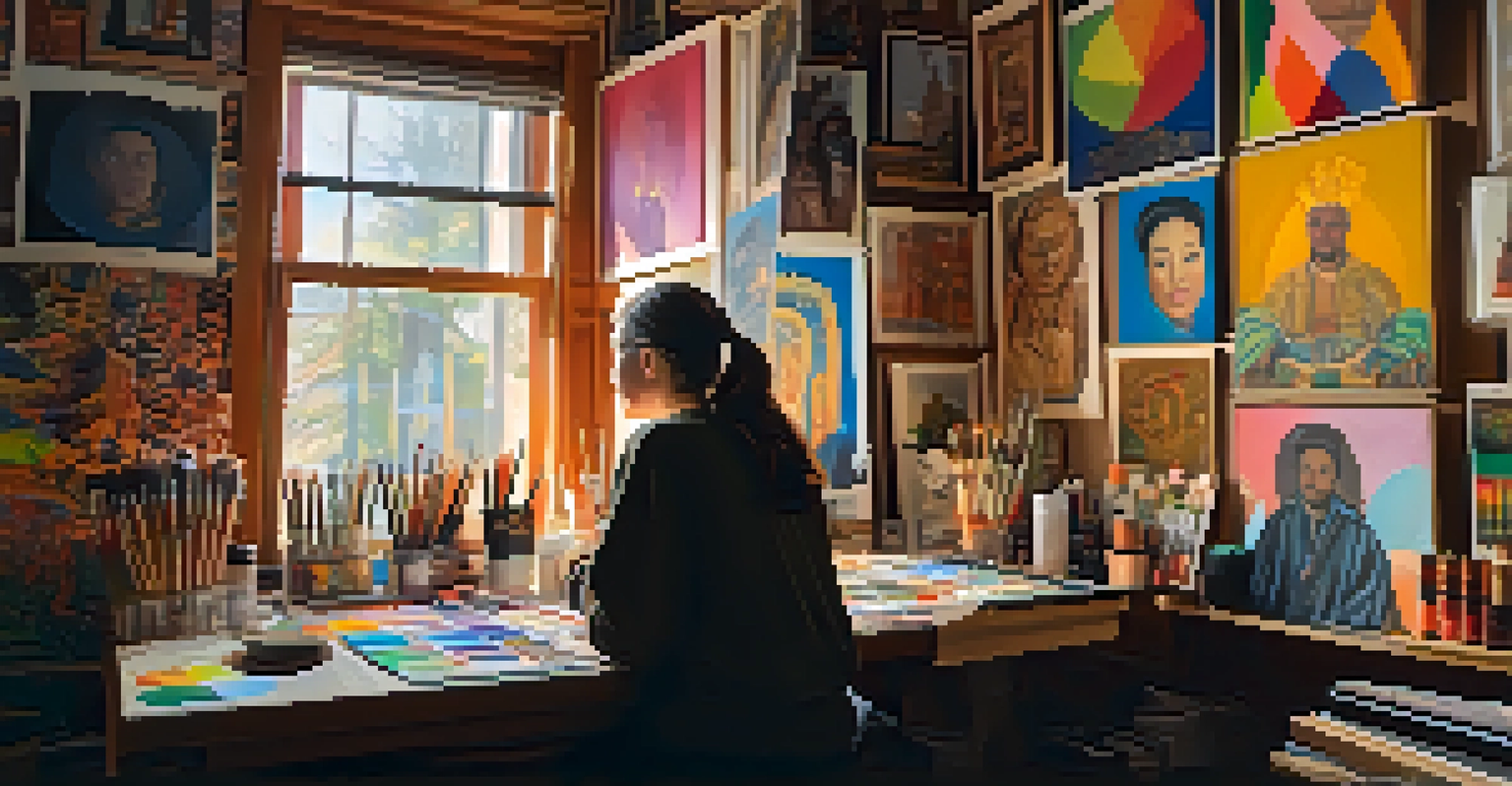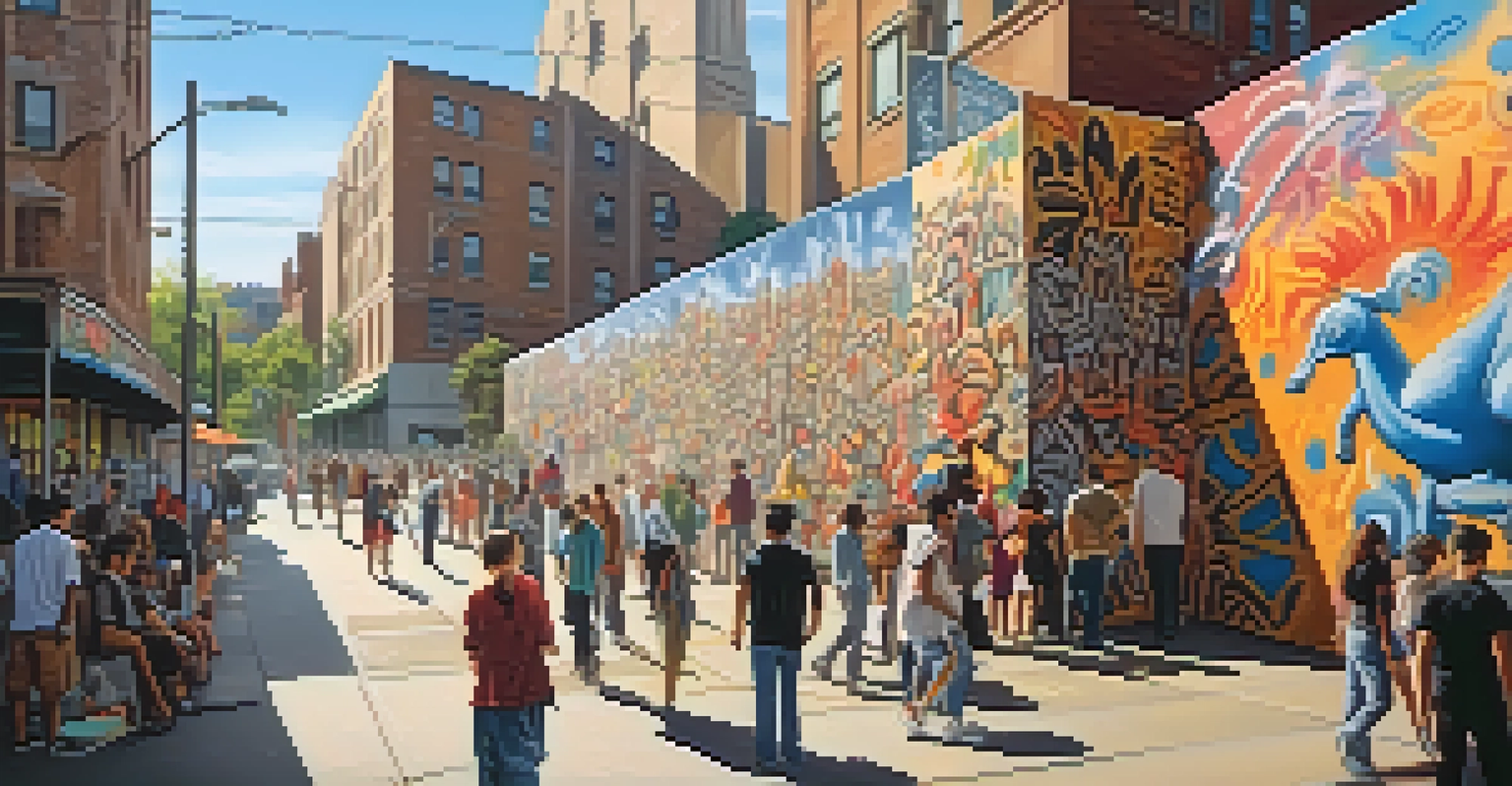Cultural Symbols in Art: Reflecting Identity and Beliefs

Understanding Cultural Symbols in Art
Cultural symbols in art serve as visual representations of shared beliefs and values. They reflect the identity of a community and can provide insights into their history and traditions. For example, the lotus flower in many Asian cultures symbolizes purity and rebirth, capturing deep spiritual significance.
Art is the most beautiful of all lies; it is a symbol of the truth that we cannot express in words.
Artistic expressions often incorporate these symbols to convey messages that resonate with specific audiences. When viewers recognize these symbols, they connect emotionally and intellectually with the artwork. This connection fosters a dialogue between the artist and the audience, enriching the overall experience.
Related Resource
Moreover, cultural symbols help preserve the identity of groups, especially in a fast-changing world. By embedding their symbols in art, communities can communicate their unique stories and perspectives, ensuring that their heritage is celebrated and remembered.
The Role of Identity in Artistic Expression
Identity plays a crucial role in shaping an artist's work, influencing both content and style. Artists often draw from their personal experiences, cultural backgrounds, and social contexts to create pieces that reflect who they are. For instance, Frida Kahlo's self-portraits are rich with symbols that express her Mexican heritage and personal struggles.

Through these expressions, artists convey not just their identity but also the collective identity of their culture. This creates a tapestry of narratives that enrich the art world. The layers of meaning embedded in such works invite viewers to explore the complexities of identity.
Cultural Symbols Reflect Identity
Cultural symbols in art visually represent shared beliefs and values, offering insights into community identity and heritage.
Ultimately, art becomes a powerful tool for self-exploration and cultural representation, allowing artists to challenge stereotypes and highlight the richness of their identities. By doing so, they encourage others to embrace their own backgrounds and stories.
Exploring Beliefs Through Artistic Symbols
Beliefs, whether religious, spiritual, or philosophical, are often depicted through symbols in art. These symbols can transcend language barriers, allowing individuals from different cultures to find common ground. For example, the cross symbolizes Christianity, while the yin-yang represents balance in Taoism.
Culture is the widening of the mind and of the spirit.
Artists use these symbols to provoke thought and evoke emotions, inviting viewers to reflect on their own beliefs. By engaging with these symbols, audiences can explore diverse perspectives and deepen their understanding of various cultures. This dialogue can lead to greater empathy and appreciation for differences.
Related Resource
Moreover, the interpretation of these symbols can evolve over time, reflecting changing societal values. As new generations engage with art, they may find fresh meanings in age-old symbols, showcasing the dynamic relationship between art, belief, and culture.
Case Studies: Iconic Artworks and Their Symbols
Examining iconic artworks can reveal how cultural symbols are intricately woven into artistic narratives. Take, for instance, Vincent van Gogh's 'Starry Night,' where swirling skies and vibrant colors express his emotional turmoil and connection to the universe. These elements serve as symbols of his inner struggles and aspirations.
Another example is Gustav Klimt's 'The Kiss,' where the use of gold leaf signifies love and spiritual union. The intricate patterns and symbols reflect not only personal feelings but also broader themes of beauty and intimacy in relationships. Each element in Klimt’s work carries symbolic weight, inviting interpretation.
Art Connects Personal and Collective
Artists express their personal identities through symbolic representations, creating a dialogue that reflects both individual and cultural narratives.
These case studies illustrate how artists harness the power of symbols to convey complex ideas and emotions. They create a rich tapestry of meaning that encourages viewers to delve deeper into the cultural contexts surrounding the artwork.
Cultural Symbols and Modern Art Movements
Modern art movements often challenge traditional notions of culture and symbolism. Artists like Jean-Michel Basquiat incorporated graffiti and street art elements that reflect urban identity and social issues. His work is filled with symbols that critique power structures and highlight marginalized voices.
Similarly, contemporary Indigenous artists utilize traditional symbols to reclaim narratives and promote cultural awareness. They merge modern techniques with ancestral symbols, creating a dialogue between the past and present. This fusion allows for a vibrant exploration of identity in a contemporary context.
Related Resource
These movements showcase how cultural symbols are not static; they evolve and adapt to new artistic landscapes. By embracing change, artists can reflect the dynamic nature of identity and beliefs in an increasingly globalized world.
The Impact of Globalization on Cultural Symbols
Globalization has significantly influenced how cultural symbols are perceived and utilized in art. With increased connectivity, artists can share their cultural narratives on a global stage, leading to a cross-pollination of symbols and ideas. This exchange can enrich artistic expression, but it also raises questions about cultural appropriation.
For instance, when artists from one culture adopt symbols from another, it can lead to misunderstandings or misrepresentations. This highlights the importance of context and respect in the artistic process. Artists must navigate these complexities to ensure that their work honors the cultures they draw from.
Globalization Shapes Artistic Symbols
Globalization influences how cultural symbols are perceived and utilized in art, fostering both enrichment and challenges related to cultural appropriation.
Ultimately, globalization can foster a deeper understanding of cultural symbols, but it requires sensitivity and awareness. By engaging thoughtfully with diverse influences, artists can create work that celebrates and respects the rich tapestry of global cultures.
Preserving Cultural Identity Through Art
Art plays a vital role in preserving cultural identity, especially in communities facing challenges such as migration or globalization. Through artistic expression, individuals can celebrate their heritage and share it with others. This not only strengthens their sense of belonging but also educates outsiders about their culture.
Many artists actively engage in this preservation by incorporating traditional symbols and techniques into their work. For example, Indigenous artists often use traditional materials and stories to convey their cultural significance, ensuring these practices are not lost to time. Their art serves as a bridge connecting past and future generations.

Moreover, art can act as a form of activism, advocating for cultural rights and representation. By showcasing their identities through symbols, artists can raise awareness and promote dialogue about the importance of cultural preservation in a rapidly changing world.